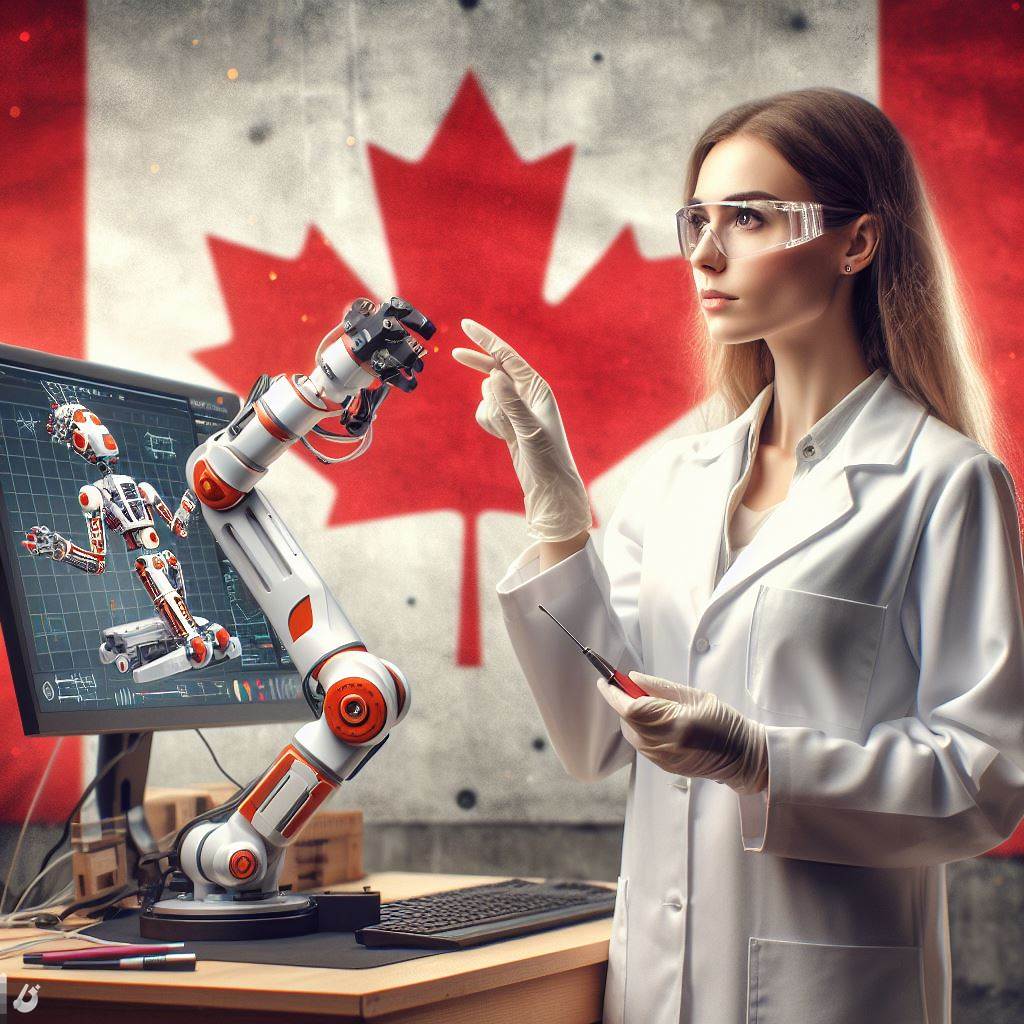Introduction
Mech Engineers and Robotics in Canada
Canada stands at the forefront of technological innovation, particularly in the dynamic realm of mechanical engineering and robotics.
This field, integral to Canada’s industrial landscape, is a hotbed of groundbreaking advancements.
Importance in Today’s Technological Advancements
Mechanical engineers and roboticists play a pivotal role in shaping the future.
Their expertise drives progress in automation, artificial intelligence, and sustainable technologies, catapulting Canada into a global tech powerhouse.
As we delve into the vibrant world of mech engineering and robotics in Canada, it’s crucial to grasp the profound impact these professionals have on our daily lives and the trajectory of technological evolution.
Overview of Mech Engineering in Canada
Overview of the Mechanical Engineering Field in Canada
Mechanical engineering is a diverse field in Canada, encompassing various industries such as aerospace, automotive, and manufacturing.
It involves designing, developing, testing, and maintaining mechanical systems and devices.
Mechanical engineers in Canada are responsible for creating innovative solutions to complex problems.
This field offers numerous opportunities for career growth and job satisfaction.
Educational Requirements and Skills Needed to Become a Mechanical Engineer in Canada
To become a mechanical engineer in Canada, one must complete a bachelor’s degree in mechanical engineering.
Several universities and colleges across the country offer accredited programs in this field.
These programs provide students with a solid foundation in mathematics, physics, and engineering principles.
Additionally, practical experience through internships or co-op placements is highly beneficial.
Strong analytical and problem-solving skills are essential for success in this profession.
Attention to detail, creativity, and teamwork are also important qualities for mechanical engineers.
Proficiency in computer-aided design (CAD) software and other engineering tools is necessary.
Moreover, staying updated with the latest advancements in technology is crucial to thrive in this field.
Licensing as a professional engineer (P.Eng) is required to practice as a mechanical engineer in Canada.
This involves passing the Professional Practice Exam and accumulating relevant work experience.
Continuing education is necessary to maintain the P.Eng designation and keep up with industry stand
Read: Skills Every Canadian Technician Must Have
Role of Mech Engineers in Robotics
Relationship between mechanical engineering and robotics
Mechanical engineering and robotics are closely intertwined disciplines.
Mech engineers design and develop robotic systems, leveraging their knowledge of mechanics and technology.
They apply principles of physics, mathematics, and materials science to create efficient and functional robots.
Precision design, manufacture, and maintenance of robots fall under the realm of mechanical engineering.
By understanding mechanical systems, mech engineers ensure optimal performance and safety in robotics.
Their expertise in designing mechanical components helps in developing reliable and robust robots.
From the mechanical structure to actuators and sensors, mech engineers contribute crucially to robotics.
Unlock Your Career Potential
Visualize a clear path to success with our tailored Career Consulting service. Personalized insights in just 1-3 days.
Get StartedThey also work on the integration of various subsystems, such as power supply and communication, in robots.
Mechanical engineering knowledge enables them to improve the efficiency and accuracy of robotic systems.
In fact, mechanical engineering provides the foundation for the design, development, and integration of robots.
How mech engineers contribute to the development and innovation in the field of robotics
Mech engineers play a vital role in the development and innovation of robotics.
They apply their expertise to enhance the capabilities and performance of robotic systems.
Through continuous research, mech engineers improve the efficiency and productivity of robots.
They focus on developing novel mechanisms and components that enable robots to perform complex tasks.
Efforts are made to optimize the design of robotic arms, joints, and grippers for precise movements.
Mechanical engineers strive to reduce the size, weight, and cost of robotic systems without compromising functionality.
They work on improvements in kinematics and dynamics to enhance the motion control of robots.
Innovative sensors and actuators are developed by mech engineers to improve robots’ perception and interaction skills.
They also contribute to the field of human-robot interaction, making robots more intuitive and user-friendly.
Integration of advanced materials and smart systems are explored by mechanical engineers for futuristic robotic applications.
Collaborating with other experts, they pioneer advancements such as soft robotics and swarm robotics.
Mech engineers also ensure the safety and reliability of robots through rigorous testing and validation.
By driving innovation, mech engineers shape the future of robotics and its impact on various industries.
In short, the contributions of mech engineers drive the development and innovation in robotics.
Read: Interview: Veteran Technician Shares Insights
Robotics Industry in Canada
Overview of the robotics industry in Canada
- Canada’s robotics industry is experiencing significant growth in recent years.
- Many companies and research institutions in Canada are actively involved in robotics development.
- The Canadian government has also been supportive, providing funding and resources to promote robotics.
- Major cities like Toronto, Montreal, and Vancouver are becoming hotspots for robotics innovation.
- Canadian robotics companies are known for their expertise in autonomous systems, artificial intelligence, and machine learning.
Growth and potential of robotics in various sectors
The Canadian manufacturing sector swiftly embraces robotics for automation, enhancing efficiency and freeing up human workers for complex tasks.
- Manufacturing Sector: Adoption of robotics for automation and efficiency improvement is evident, allowing human workers to focus on complex tasks.
- Healthcare Sector: Surgical robots aid doctors in performing precise complex surgeries, enhancing patient care and outcomes.
- Agricultural Sector: Robots in precision farming perform tasks like planting and harvesting, leading to increased crop yields and reduced labor costs.
- Hazardous Environments: In sectors like mining and oil and gas, robots undertake risky tasks in dangerous environments, ensuring worker safety.
- Autonomous Vehicles: Canada is actively developing and testing autonomous vehicles to revolutionize transportation.
- Entertainment Industry: Robotics contributes to entertainment with developments in animatronics and virtual reality technologies.
- Endless Possibilities: As robotics advances, its potential applications across various sectors continue to grow.
- Global Leadership: Canada, with expertise and a supportive environment, is poised to become a global leader in robotics.
- Economic Impact: The growing robotics industry is expected to create job opportunities and contribute significantly to economic growth.
- Continued Investment: Ongoing investment in research and development by the government, industry, and academia is crucial for sustained momentum.
In essence, Canada’s robotics industry exhibits rapid growth and substantial potential across sectors.
The nation’s expertise in autonomous systems and AI, coupled with consistent support, drives innovation.
From manufacturing to healthcare and beyond, robots are reshaping industries, improving productivity, and positioning Canada as a global leader with continued investment in research and development.
Read: The Role of Technicians in Canada’s Tech Boom
Cutting-edge Robotics Research in Canada
Notable Research Institutions and Organizations in Canada
- University of Waterloo: Known for its strong focus on robotics research, the university has several labs dedicated to the field.
- University of Toronto: Renowned for its Robotics Institute, which conducts groundbreaking research in various areas of robotics.
- Canadian Robotics Network: A national network that promotes collaboration among researchers and institutions across Canada.
- National Research Council of Canada: The NRC’s Industrial Research Assistance Program provides support to companies working on robotic technologies.
- University of British Columbia: Conducts research in human-robot interaction, medical robotics, and autonomous systems.
Recent Advancements and Breakthroughs in Robotics Research
Autonomous Vehicles
Canadian scientists and engineers are actively involved in the development of autonomous vehicles.
Various research institutions and organizations are conducting studies on self-driving cars and drones.
The University of Waterloo, for instance, has a dedicated research lab focusing on autonomous systems.
Their work aims to improve the safety and efficiency of transportation through cutting-edge technologies.
Surgical Robotics
In the field of robotic-assisted surgery, Canadian researchers have made significant advancements.
The da Vinci Surgical System, one of the most well-known surgical robots, was developed in collaboration with Canadian engineers.
This robotic system enables surgeons to perform complex procedures with enhanced precision and minimal invasiveness.
Such breakthroughs in surgical robotics have revolutionized the medical industry and improved patient outcomes.
Collaborative Robots
Canada is a leader in developing collaborative robots, also known as cobots, that can work alongside humans.
These robots are designed to assist workers in various industries, enhancing productivity and safety.
They are equipped with sensors and AI capabilities to detect human presence and adapt to different tasks.
Canadian research institutions, including the University of Toronto, are continually pushing the boundaries of collaborative robotics.
Robotics in Space
The Canadian Space Agency has a remarkable track record in robotics for space exploration.
The iconic Canadarm and its successor, Canadarm2, have played pivotal roles in the assembly and maintenance of the International Space Station.
Canadian engineers have also developed robotic systems for lunar and planetary missions.
These advancements have solidified Canada’s reputation as a leader in space robotics.
Artificial Intelligence
The integration of robotics and artificial intelligence is a burgeoning field in Canada.
Researchers are exploring new ways to apply AI techniques to enhance the capabilities of robots.
This includes developing robots with advanced perception, learning, and decision-making abilities.
By combining AI algorithms with robotics hardware, Canadian scientists are pushing the boundaries of what robots can achieve in various domains, such as healthcare, manufacturing, and agriculture.
In general, Canada boasts several notable research institutions and organizations that spearhead cutting-edge robotics research.
From autonomous vehicles to surgical robotics, Canadian scientists and engineers continue to make significant contributions to the field.
As advancements in robotics and artificial intelligence continue to unfold, Canada remains at the forefront, paving the way for the future of robotics on a global scale.
Read: Emerging Tech Trends for Technicians in Canada

Career Opportunities for Mech Engineers in Robotics in Canada
Job Prospects and Roles for Mechanical Engineers in the Robotics Industry
- Robotics has become a cutting-edge field offering numerous career prospects to mechanical engineers.
- One of the prominent job roles for mech engineers in robotics is robot design and development.
- Mech engineers are responsible for designing and constructing robotic systems with precision and efficiency.
- They also play a crucial role in integrating mechanical components with electronic and software systems.
- Another exciting opportunity in the robotics industry is working as a robotics research engineer.
- Research engineers focus on developing innovative robotic technologies and improving existing ones.
- They conduct extensive research, analyze data, and contribute to advancements in the field.
- Mech engineers can also pursue a career as a robotics systems engineer.
- Systems engineers coordinate and manage the overall integration of mechanical, electrical, and software components.
- They ensure the smooth functioning of robotic systems and troubleshoot any technical issues.
- Automation engineers specialize in streamlining and optimizing industrial processes using robotics.
- They design automated systems for manufacturing, assembly lines, and other industrial applications.
- Mech engineers can also work as robotics project managers, overseeing the development and implementation of robotic projects.
The Demand for Skilled Mech Engineers in Canada’s Robotics Sector
- The robotics sector in Canada sees a substantial demand for skilled mechanical engineers.
- Increasing automation and robotics across industries are driving this demand for expertise.
- Industries like manufacturing, healthcare, and agriculture heavily depend on robotics.
- This dependence creates a specific demand for mechanical engineers well-versed in robotics systems.
- Ongoing investments in research and development by Canadian companies result in expanding job opportunities.
- Government support for technological advancements further amplifies the demand for skilled engineers.
- Mechanical engineers with expertise in automation, control systems, and robotics enjoy a competitive edge.
- The demand is not region-specific but prevalent nationwide in Canada.
- Major cities like Toronto, Vancouver, and Montreal witness significant requirements for mechanical engineers.
- The robotics sector promises an attractive salary range, making it an appealing career path.
- Professional growth, research collaborations, and involvement in cutting-edge projects are additional benefits.
- Mechanical engineers contribute to positioning Canada as a global hub for innovation and robotics.
- As the field advances, the demand for skilled mechanical engineers in robotics is expected to rise.
In a nutshell, Canada’s robotics industry presents diverse career opportunities for mechanical engineers.
Roles span from design and development to research and project management, meeting various professional aspirations.
The growing reliance on robotics in Canadian industries fuels demand, creating a dynamic job market.
With government support and continuous investments, the sector is poised for further expansion, offering more prospects for mechanical engineers.
Those with expertise in automation, control systems, and robotics can anticipate competitive salaries.
Choosing a career in robotics allows mechanical engineers to contribute to Canada’s technological progress and engage in an innovative field.
Challenges and Future Trends in the Field
Challenges Faced by Mech Engineers and the Robotics Industry in Canada
- Limited funding opportunities for research and development projects in the field.
- Shortage of skilled Mech engineers and robotics experts, leading to talent scarcity.
- Increasing competition from global players with advanced technologies and lower production costs.
- Compliance with stringent safety regulations and ethical considerations in developing autonomous robots.
- Complex integration of mechanical, electrical, and software components in robotics systems.
- Limited public awareness and understanding of the benefits and potential of robotics technology.
- Balancing the need for automation with job displacement concerns in various industry sectors.
- Adapting to rapid technological advancements and constantly evolving industry standards.
Emerging Trends and Technologies Shaping the Future of Mech Engineers and Robotics in Canada
- Artificial Intelligence (AI): Integration of AI technologies in robotics for enhancing decision-making and autonomous capabilities.
- Collaborative Robots (Cobots): Development of robots that can safely work alongside humans, increasing productivity and efficiency.
- Internet of Things (IoT): Integration of robotics with IoT for seamless connectivity and data exchange in industrial automation.
- 3D Printing: Application of additive manufacturing in robotics for rapid prototyping and customized production.
- Human-Robot Interaction: Focus on developing natural and intuitive interfaces to enhance human-robot collaboration.
- Robotics in Healthcare: Utilizing robots for surgeries, assisting the elderly, and improving rehabilitation procedures.
- Sustainable Robotics: Development of environmentally friendly and energy-efficient robots to reduce carbon footprint.
- Drone Technology: Expanding applications of drones in various industries, including agriculture, surveillance, and delivery services.
The Future Outlook
The challenges faced by Mech engineers and the robotics industry in Canada are significant.
However, emerging trends and technologies demonstrate a promising future for the field.
With increased investment in research and development, Canadian Mech engineers and robotics experts can overcome funding limitations and attract top talent.
Collaboration between industry, academia, and the government can foster innovation and address the shortage of skilled professionals.
To stay competitive in the global market, Canadian companies must focus on developing advanced technologies and cost-effective solutions.
This includes leveraging AI, Cobots, IoT, and 3D printing to enhance productivity, efficiency, and product quality.
Ethical considerations and safety regulations will continue to play a crucial role in shaping the development of robotics technology.
Balancing automation with job displacement concerns will require careful planning and skill development initiatives to prepare the workforce for new roles and opportunities.
As technology evolves, the integration of robots with AI, human-robot interaction, and sustainability will redefine the robotics landscape in Canada.
These advancements will lead to breakthroughs in healthcare, agriculture, logistics, and other sectors.
In review, while challenges persist, the future of Mech engineers and robotics in Canada holds immense potential.
By embracing emerging technologies, fostering innovation, and addressing talent gaps, Canada can become a global leader in the field of robotics.
Conclusion
Summarize the Key Points
In Canada, mech engineers play a pivotal role in shaping the future of robotics.
They fuse mechanical prowess with cutting-edge technology, propelling innovation.
This dynamic synergy fosters advancements in automation, artificial intelligence, and beyond.
The blog delved into the multifaceted contributions of mech engineers to Canada’s burgeoning robotics landscape.
From designing sophisticated robotic arms to programming intricate algorithms, these professionals are at the forefront of transformative change.
Reinforce Significance in Robotics
Mech engineers form the backbone of Canada’s robotics sector, steering it toward unparalleled growth.
Their expertise empowers industries, driving efficiency and sparking breakthroughs in fields like healthcare, manufacturing, and space exploration.
The symbiotic relationship between mech engineering and robotics is propelling Canada to the forefront of global technological leadership.
Encourage Career Pursuit
As the blog concludes, aspiring minds are urged to consider a career in mech engineering and robotics in Canada.
The nation’s commitment to innovation, coupled with a robust support system, provides an ideal environment for budding engineers.
Join the league of visionaries, contribute to the ever-evolving world of robotics, and be part of Canada’s remarkable journey into the future.
Seize the opportunity, embrace the challenge, and shape the next era of technological marvels in mech engineering and robotics.




